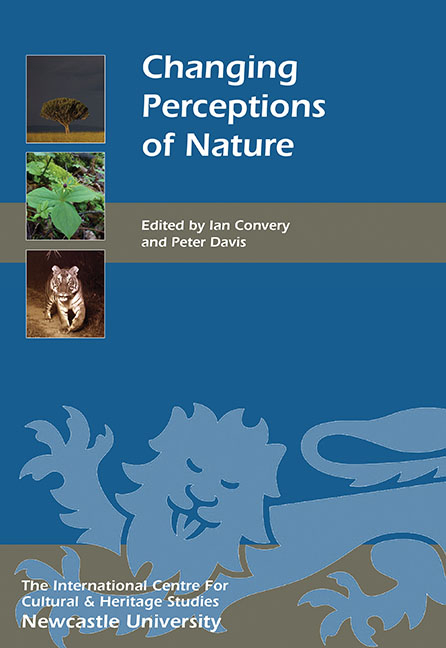Book contents
- Frontmatter
- Contents
- List of Illustrations
- Acknowledgments
- List of Abbreviations
- Foreword
- Introduction
- HISTORICAL PERSPECTIVES ON NATURE
- COLLECTING NATURE
- INTERPRETING NATURE AND LANDSCAPES
- CONSERVING NATURE
- 18 The Public Perception of Protected Areas in the UK
- 19 Conservation of Rare Species and Natural Heritage: the Wild and the Tame
- 20 Our Vanishing Natural Heritage and The Wildlife Trusts: a Century of Influence and Local Action for Nature and People
- 21 A Champion of the Tiger's Cause
- PEOPLE–NATURE INTERACTIONS
- List of Contributors
- Index
- Miscellaneous Endmatter
19 - Conservation of Rare Species and Natural Heritage: the Wild and the Tame
from CONSERVING NATURE
Published online by Cambridge University Press: 26 October 2017
- Frontmatter
- Contents
- List of Illustrations
- Acknowledgments
- List of Abbreviations
- Foreword
- Introduction
- HISTORICAL PERSPECTIVES ON NATURE
- COLLECTING NATURE
- INTERPRETING NATURE AND LANDSCAPES
- CONSERVING NATURE
- 18 The Public Perception of Protected Areas in the UK
- 19 Conservation of Rare Species and Natural Heritage: the Wild and the Tame
- 20 Our Vanishing Natural Heritage and The Wildlife Trusts: a Century of Influence and Local Action for Nature and People
- 21 A Champion of the Tiger's Cause
- PEOPLE–NATURE INTERACTIONS
- List of Contributors
- Index
- Miscellaneous Endmatter
Summary
INTRODUCTION
Natural heritage is an umbrella term that can be used for a place, an ecosystem, or a wild or domestic living species that a person or a group of people cares about and wishes to preserve. The practical and philosophical reasons for this preservation change through time can be affected by innumerable factors and often in unpredictable ways. An interesting example is the spread of the phrase ‘the noble savage’ throughout European literature and hence into popular recognition after it was used by the poet John Dryden (1631–1700) in his stage play, The Conquest of Granada, published in 1672. The subsequent literary dispersal of this term has had a pervasive influence on Western philosophy and attitudes to the natural world, but I believe it was based on a false premise.
I am as free as nature first made man,
Ere the base laws of servitude began,
When wild in woods the noble savage ran.
Dryden's plot was about an imaginary battle fought between two factions of Moors during the long war between the Moors and the Spanish, which ended with the final fall of Granada in 1492 when all Muslims and Jews were evicted from the Iberian Peninsula. The ‘noble savage’ in Dryden's play is the hero Almanzor, a Moor, who is defending himself against another Moor, Boabdelin, but it is much more likely that Almanzor is referring to himself as an aristocrat disguised as a savage than as a man living the noble life of freedom in the wild. In fact, it is questionable whether Dryden would have believed in the purity and freedom of the natural world. Moreover, in the writings of the ancient classics, and right up to the time of Darwin, promoters of the many different versions of the hierarchical Great Chain of Being, ‘savages’ were placed as physical and mental beings below European humans, and there was nothing noble about them (Lovejoy 1936). But Jean-Jacques Rousseau (1712–1778) and other philosophers of the Enlightenment had different views.
- Type
- Chapter
- Information
- Changing Perceptions of Nature , pp. 195 - 202Publisher: Boydell & BrewerPrint publication year: 2016

